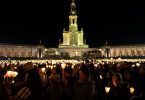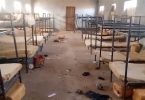
People enjoy the sunset on Manila Bay, Philippines, in this Jan. 20, 2015, file photo. Manila area church officials raised concerns over proposed reclamation projects in the metro area that they said may not be environmentally sound and would likely affect the livelihood of the poor in those areas. (CNS photo/Tyler Orsburn)
By Simone Orendain
MANILA, Philippines (CNS) — Manila area church officials said proposed land reclamation projects in the metro area may not be environmentally sound and would likely affect the livelihood of the poor.
Msgr. Jose Clemente Ignacio, Manila Archdiocese vicar general, said a 365-acre proposed tourist city on an elevated platform, “Solar City,” in Manila Bay, is a particular concern for the church.
“We see the dangers that it will cause to society, to marine life, to our food, for our livelihood, so all these things will affect us,” Msgr. Ignacio told Catholic News Service. “And because of man’s self-centered concept of development and growth and profit-orientedness, we do not see the effect it will have. Especially for the poor.”
Msgr. Ignacio said Pope Francis’ encyclical “Laudato Si’, on Care for Our Common Home,” makes a clear connection between advocating for creation and social justice and how “capitalistic philosophies” have an impact on the environment and the poor.
He said since Manila Cardinal Luis Antonio Tagle was a bishop in Cavite province, south of Manila, he has been raising the issue of reclamation in the bay and had written a letter about it to President Benigno Aquino III.
The Manila Archdiocese Office on Ecology hosted a forum in mid-February to weigh the pros and cons of the proposed Manila Bay project as well as a proposed 29-mile expressway-dike system at nearby Laguna de Bay, the largest lake in the Philippines.
In a presentation, Kelvin Rodolfo, professor emeritus of earth and environmental sciences at the University of Illinois at Chicago, gave examples of several hazards posed by land reclamation. He said water makes reclaimed ground sink and, with typhoons getting progressively stronger, they bring higher storm surges. He added the reclaimed ground could liquefy should an earthquake strike the Philippine capital. The Philippines is part of the Pacific Ring of Fire, a string of countries in the Pacific basin with active volcanoes whose tectonic plates shift, causing quakes.
He told CNS afterward: “The sad thing is, I don’t know how many times something bad happens and people come to me and say, ‘You were right.’ As if it was to make me feel good.”
Francis Tan, internal urban planner for the Manila Gold Coast Reclamation Project, which is behind Solar City, said measures were being taken to mitigate flooding.
Tan told CNS the project’s engineering allows for water refraction and dissipation to handle big waves and that a containment wall is being planned to manage flooding during major storms. Tan said it will produce 500,000 jobs and, since this is a private project, it is expected to generate $210 million yearly in tax revenues, which could fund social programs and infrastructure development in Manila.
Tan said as far as the flood mitigation measures, the project obtained a “no objection” letter from the Philippine Department of Public Works and Highways, while the Department of Environment and Natural Resources deemed it “environmentally compliant.”
“We’re really trying to do right by this city and this country,” said Tan. “We’re really not trying to cut corners.”
While the Solar City project expects to clear all government requirements before July, after which it can start building, the Laguna expressway project is still in the early stages. A representative of the government agency issuing permits for Laguna developments said it would be open for bidding by private companies March 14.
But Monico Capati, a fisherman, said even without the expressway project, he and his fisher folk colleagues have been barred from their usual fishing area.
Capati attended the forum and told CNS that Taguig, where he lives in southern metro Manila, was already working with a private company on a reclamation project separate from the national expressway plan. Capati, 71, said he had been fishing at his old spot for 40 years, and he was worried about the bigger project coming.
“Since 2014 . . . I’ve been earning less than half, from what I used to catch,” said Capati as he rifled through a clear plastic folder containing letters and documents addressed to government officials. “I was earning about $21 a day . . . for big fish like tilapia. Now it’s about $6.30 … we have to go farther out into the lake where there are far fewer fish.”
Rodolfo said the planned expressway would be situated on a fault line that geologists predict will cause a major quake in metro Manila.
Lou Arsenio, head of the Manila archdiocesan ecology office, told CNS: “As of now we are leaning toward making a recommendation to the bishops, based on [Rodolfo’s] findings . . . that this kind of reclamation should not really be undertaken. But we would like to have a complete picture.”
Representatives of her office were scheduled to meet with marine scientists March 2.






